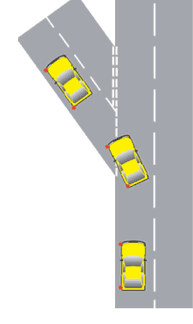Lesson Plan 3 - Approaching Junctions
Approaching junctions to turn left
This will mainly be when you are leaving a main road to turn into a road on your left. To do so you should follow the M-S-M routine.
Priority
When turning left you will have priority over traffic turning right off the main road (priority over the blue car as shown in the diagram) as they will be cutting across your path.
Mirrors
Checking the interior first will give the best view of approaching traffic and an idea of their speed.
Check left/nearside mirror next to be aware of any traffic that may be about to pass on the left as you slow down to take turn, mainly cyclists/motorbikes.
Signal
Signal in good time but not too early which may confuse other road users (they may think you are pulling up on the left).
Position
There would be no need to change from your normal driving position unless there are obstructions (parked cars) or if you are turning into a narrow road or entrance. For a sharp turn you would need to move closer to the centre of the road.
Speed
Slow down enough to take turn safely – most turns would be taken at approximately 15-20 mph (second gear should be selected for this speed). Bring clutch pedal up to avoid coasting to maintain control.
Look
Check into new road to assess how clear the junction is. Look out for parked cars or pedestrians who could easily be crossing the road. Be aware of any cyclists who may try passing you on the left. Pedestrians who have stepped onto the road have priority so be prepared to stop and allow them to cross if necessary!



Pedestrians
Look out for pedestrians and parked cars.
Timing of signal
If you are turning into the second side road do not signal until passing the first junction.
Taking a sweeping turn
Here, your view into the new road would be much clearer and it will be easier to maintain control of your car with less steering needed for the turn, therefore, you may not need to slow down as much as for a standard turn. If you have not needed to slow down much you can often take these turns in third gear.
Approaching junctions to turn right
Priority
Oncoming traffic will have priority – you must not cut across them if to do so would cause them to change speed or direction. If you can walk across then you can drive across!
Stopping Position
Position just before your point of turn (marked with a + on the diagram below) when you need to stop for oncoming traffic or if the road you intend on turning into is blocked – this will make it easier to turn in the correct position. Positioning to the centre of the road will often leave enough room for cars to pass on your left as well as confirm your intentions to turn. Do not cut the corner.
Flashing Lights
Be prepared for the possibility of the other driver beckoning you on, most likely by flashing their headlights or waving you on. You must make sure it is safe to turn and they are beckoning you on and nobody else, especially where there are vehicles emerging onto the main road that they may be intended for.
Mirrors
Interior first will give the best view of approaching traffic and an idea of their speed. Check right/offside mirror next to be aware of any vehicles that may be overtaking.
Signal
Signal in good time to warn other road users of your intentions – you will be affecting people more due to needing to change position before turn and you may need to stop.
Position
Move over to the centre of the road where possible – this will not only confirm your intentions to turn right but on many roads will leave enough room for following traffic to pass on the left.
Speed
Slow down enough to take turn safely or to stop smoothly if it’s not clear to go due to oncoming traffic or if the road you are entering is blocked.
Look
Look out for oncoming traffic as they have priority, check into road you are entering to see if clear – possibly pedestrians may be crossing/the road may be blocked due to parked cars with emerging traffic.
Equal Priority
Try to gain eye contact with the other driver when possible in order to help judge their intentions. Your options are to hold back to allow the oncoming car to turn before you or:
- Turn nearside to nearside. This is where you would turn before oncoming traffic.
- Turn offside to offside. Where you would pass oncoming vehicle and then turn. (See diagram on emerging)
If turning nearside to nearside you must do so without cutting the corner and be mindful of any other oncoming traffic, especially bikes.




One Way
Look out for One Way signs.
Filter Lanes
When turning right off main roads, when the road is wide enough you will often have filter lanes to use, which help to keep traffic flowing by allowing vehicles to pass on the left. Try to enter the filter lane as soon as you are clear of the chevron markings. Do not drive over the chevron markings unnecessarily.
